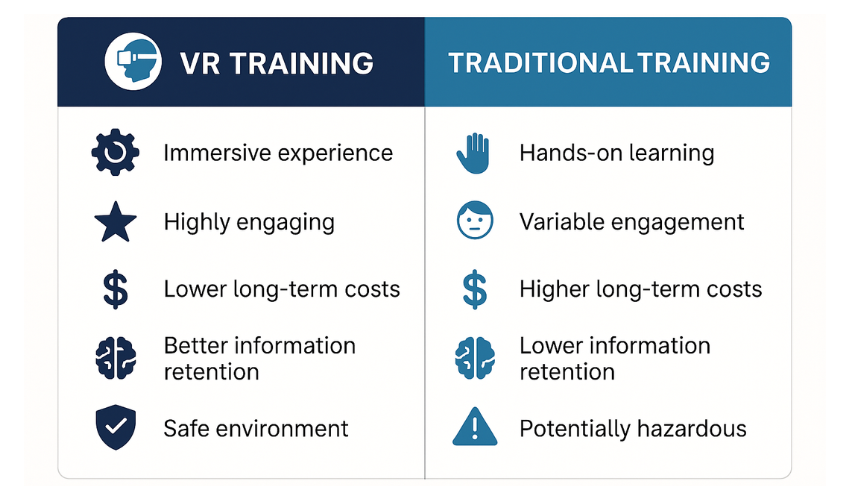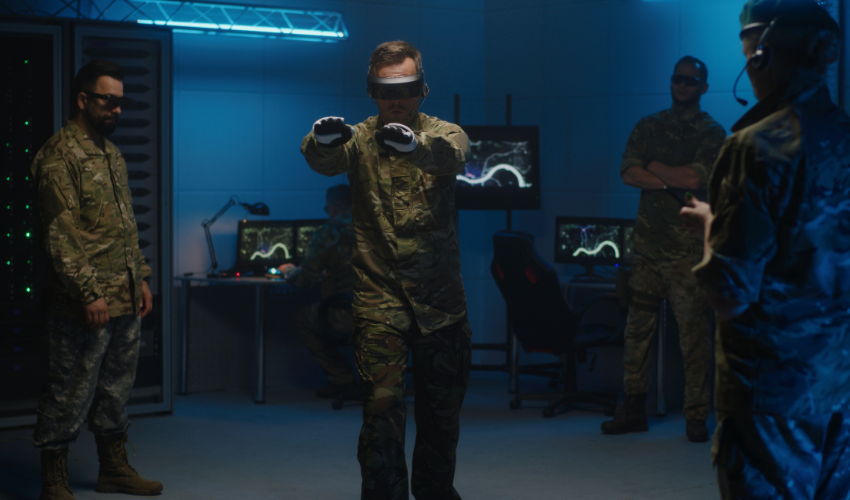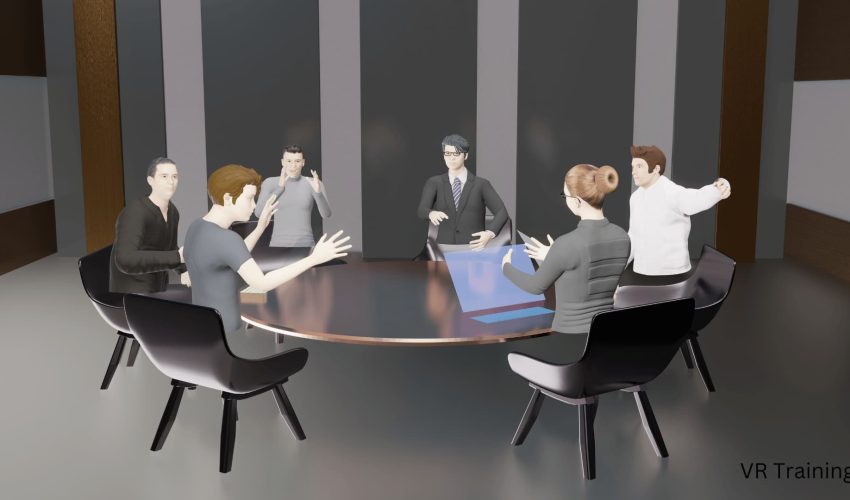11 Powerful VR Training Benefits Transforming Businesses in 2025
Share it
The Benefits of Immersive Learning
VR training benefits go far beyond cost savings. Companies are now using immersive simulations to boost learning retention, accelerate onboarding, and improve employee performance in ways that traditional methods can’t match.
Imagine starting a new job and handling complex machinery on day one.
Nervous? What if you could master it in a risk-free virtual environment where mistakes are just part of the learning process? This is the power of VR training.
Virtual Reality (VR) isn’t just a trendy concept anymore; it’s transforming corporate training. For employers and employees, VR training offers immense benefits. From cutting costs and reducing training time to minimizing errors and boosting engagement, VR training is very practical.
With VR, you can simulate real-world scenarios at a fraction of the cost, making training more efficient and effective.
Let’s see how it can enhance your organization’s training programs.
Benefits of VR Training: A New Horizon
When it comes to training, the conventional methods often include dull PowerPoint presentations, lengthy manuals, online tutorials, face-to-face workshops, instructor-led and on-the-job training, and generic approaches that may not always be the most inspiring.
VR training provides many benefits that can genuinely improve the training experience.
On the other hand, VR training offers numerous benefits that can significantly enhance the training experience.
Training with virtual reality offers a turning point in employee training and development, from immersive learning environments to cost-effective solutions.
1.) The Immersive Experience of Virtual Reality
Real-World Simulation
Imagine preparing for a high-stakes surgical procedure, a critical military operation, and working through a challenging customer service scenario without the risks involved.
That’s where VR on-the-job training comes in.
According to a 2019 study conducted by UCLA’s David Geffen School of Medicine, the use of the OssoVR Platform resulted in a remarkable 230% improvement improvement in participants’ surgical performance compared to traditional learning methods.
Isn’t that incredible?
It just goes to show the incredible potential of this groundbreaking technology.
It allows learners to make mistakes and practice in a safe and controlled environment, providing a real-world simulation like no other.
With this level of immersion, you’ll get a truly hands-on experience that traditional training methods can’t match.
Emotional Engagement
When diving into a virtual world, prepare for an incredible emotional journey.
The training scenarios feel so real that you’ll find yourself reacting just like you would in a real-world situation.
This intense emotional connection takes your learning experience to the next level, making training sessions truly unforgettable.
2.) Cost-Effectiveness of Virtual Reality Training
Reduced Training Expenses
The initial investment in immersive training may seem steep, but the long-term benefits are substantial.
Futurevisual.com estimates that a small custom pilot ranges around $25K to $130K for large programs.
However, off-the-shelf courses are always expanding and thus also reducing prices.
Think about it: Traditional training often comes with travel expenses, venue bookings, equipment to manipulate, and printed materials.
With VR, all these costs are eliminated, making it a much more cost-effective method in the long run.
Long-Term Savings
In addition to the immediate cost savings, VR training brings long-term financial benefits.
Not only does it enhance learning retention and employee productivity, but it also directly contributes to a company’s bottom line.
This makes the return on investment for training in VR highly favorable.
A recent report by PWC found that learners were 4 times faster to train with VR and 3.75 times more emotionally connected to content than in the classroom.
So, it’s not just about saving money upfront but also about reaping the long-term rewards that make VR training a smart choice.

Learners were 4 times faster to train with VR and 3.75 times more emotionally connected to content than in the classroom.
- PwC -
3.) Accessibility and Convenience
Anytime, Anywhere Learning
One of the awesome benefits of VR training is its incredible convenience.
Employees can access lessons anytime, anywhere, giving them the flexibility to learn at their own pace, schedules, and locations.
In-person VR training is a great option for organizations with on-site VR technology. It allows employees to come together, engage in training, and provide real-time feedback and collaboration.
This is particularly beneficial for team-building exercises or hands-on instructor-guided training.
Imagine a medical facility using in-person VR training to teach surgical procedures. Trainees and experienced surgeons engage in simulated surgeries, receiving real-time feedback from the instructor. This hands-on approach is invaluable for mastering complex tasks in medicine.
Remote VR Training is a game-changer for teams or individuals unable to attend in-person sessions.
With just a VR headset and stable internet, dive into interactive modules from the comfort of your home or remote office.
No more boring training sessions! 🚀
Imagine this: A global corporation with offices in multiple countries making use of remote VR training to bring their training programs to a whole new level of awesomeness! 🌍💻
No matter the location, employees can gather in a virtual training room led by an exceptional instructor. 🌟
This means standardized training without the logistical headaches of physical gatherings. Let’s embrace the future of training and make learning an exciting journey for all! 🚀✨
Customization and Flexibility
Virtual training modules offer easy customization to cater to the specific needs of companies or individuals.
This is especially beneficial for industries with specialized requirements or companies aiming to incorporate their best practices and protocols into the training.
BMW uses virtual reality to train employees in design and prototyping. They create a lifelike environment with 3D scanning and continuously integrate participant feedback to improve the training.
This approach provides employees with realistic and effective learning experiences.
Virtual training modules offer unmatched flexibility compared to traditional methods like classroom lectures, online courses, or printed manuals.
While traditional methods allow partial content customization, their fixed format and delivery pose challenges in addressing specific needs or adapting to changing requirements.
In a traditional setting, companies print new manuals or re-record video lectures for procedure changes or new information.
This process is time-consuming and incurs additional costs.
Virtual reality offers enhanced training with adaptability and flexibility.
4.) Enhanced Learning Retention
“Is Virtual Reality Bad For Your Brain?” YouTube, uploaded by The ScienceVerse
The Science Behind Memory and VR
The brain is wired to remember experiences far better than static information, which is why experiential learning is so powerful. VR amplifies this by placing learners inside realistic, hands-on environments that mirror real-world scenarios. If you’re curious how today’s immersive training standards evolved, explore the history of VR, which shows how decades of innovation shaped the immersive design approaches used today. This depth of engagement activates more senses, strengthens neural connections, and dramatically improves long-term memory retention.
Experiential learning, or learning by doing, is one of the best methods to remember information.
When you actually participate in an activity, your brain activates multiple senses and forms stronger neural connections.
And guess what?
VR training takes full advantage of this by giving you a hands-on, immersive experience that feels just like real-world scenarios.
Imagine learning to assemble a machine. You can physically put it together in a VR environment rather than just reading a manual or watching a video.
Step into a new world, play with the parts and fully engage your senses. This multi-sensory learning experience is fun and enhances long-term memory retention.
Virtual Reality (VR) takes advantage of this by creating immersive learning environments that boost memory retention.
In a 2017 study by the National Training Laboratory, retention rates for VR learning were 75%, much higher than those for lecture-style learning (5%) and reading (10%).
Research indicates that individuals recall a remarkable 90% of what they do compared to 10% of what they read.
How amazing is that? 🤩
Real-Life Case Studies
Companies like Walmart, Verizon, Airbus, DHL Express, Intel, KFC, Bank of America, and Boeing have successfully implemented immersive technology programs, significantly improving employee performance and learning retention.
These real-life case studies serve as a testament to the efficacy of VR training.
If you’re curious about different virtual training options available for your business, explore these different VR training solutions tailored to your industry needs.
5.) Improved Employee Productivity
“How Hilton Uses VR For Training”, YouTube, uploaded by Meta Quest
Faster Onboarding
New employees can level up their skills more efficiently with the power of VR training!
The immersive experience helps them quickly grasp company protocols, resulting in reduced onboarding time and making them valuable team players in no time.
Consider a tech company that traditionally takes two weeks to onboard new software developers using classroom lectures and online tutorials.
By switching to VR-based training that simulates real-world coding challenges and team collaboration, the company finds that new hires are ready to contribute to projects in just one week.
This cuts the onboarding time in half, allowing new employees to become productive members of the team much faster.
Skill Enhancement
VR training isn’t just for beginners; it’s also an awesome tool to enhance skills among our existing employees.
We can develop advanced modules to help them master new technologies or procedures, boosting their productivity along the way.
6.) Risk Mitigation
“Protecting Verizon’s Workforce With Immersive Learning,” YouTube, uploaded by Strivr.
Prepare for a store robbery.
Safety Training
VR safety training can greatly benefit the construction, healthcare, transportation, hospitality, and manufacturing industries.
Just imagine the possibilities!
For instance, consider handling hazardous materials in a chemical manufacturing plant. It’s a task with significant risks. In traditional training, employees read safety manuals and watch videos.
But with VR training, they can actually practice responding to a chemical spill in a simulated environment.
They’ll go through all the steps: isolating the area, using spill kits, and notifying emergency services.
And the best part?
They do it all without any real-world risks of handling dangerous substances.
With this innovative approach, employees can become masters at handling hazardous situations while keeping themselves safe during training.
Cool, right?
Crisis Management
Virtual Reality (VR) can simulate crisis scenarios, providing employees a controlled environment to practice their responses.
This invaluable tool is particularly beneficial for roles that demand quick decision-making under pressure, like emergency responders or airline pilots.
A study by SpringerLink demonstrated the accuracy of the first responders by a factor of 46% and the speed of executing tasks by 29%.
Quality Improvement Through Error Reduction
VR training offers a fantastic advantage: it can greatly reduce errors and improve work quality.
In a VR environment, employees are free to make mistakes without real-world consequences, allowing them to master correct procedures and techniques.
Healthcare, manufacturing, and aviation industries have much to gain from VR training, as it enhances quality and minimizes costly mistakes.
A study by M.H. Abidi et al. “reveals that participants trained by VR committed fewer errors and took less time in actual product assembly when compared against the participant from traditional or baseline training group.”
7.) Collaborative Learning Experience
“Training & Team Building in the VR Metaverse,” YouTube, uploaded by 5Discovery Virtual Learning.
Team Building
VR training is not just a solo adventure. It’s a chance to collaborate and connect. In multi-user environments, teams can come together in a virtual space, boosting team cohesion and communication skills.
For instance, a sales team at a tech company introduces VR training to simulate client meetings.
Team members enter a virtual conference room where they practice pitching to a virtual client, negotiating deals, and handling objections.
This allows them to refine their individual sales techniques and work on their team dynamics, such as who takes the lead in certain situations and how they back each other up during challenging moments.
Global Outreach
For companies with a global workforce, it allows seamless training across different geographies, breaking down distance and language barriers.
Imagine a multinational corporation with offices in New York, London, and Tokyo. VR training helps them with a company-wide compliance workshop.
All employees, no matter where they are, join the same virtual classroom.
They interact with each other and the instructor in real time, making it feel like they’re all in the same room.
And guess what?
The VR platform even offers real-time language translation so everyone can participate easily, regardless of their native language.
Amazing, right?
8.) Scalability
Easy to Update Content
One of the great benefits of virtual reality training that often goes unnoticed is how easy it is to update the content.
Unlike traditional training options that require reprinting manuals or rebooking venues, VR training modules can be updated with just a few clicks.
This means that your training program will always be up-to-date with the latest information and best practices.
Mass Training Capability
VR training is incredibly scalable, which means you can train multiple employees at once, no matter where they’re located.
This is especially great for big organizations or industries that need to introduce training programs to a large workforce swiftly.
9.) Increased Employee Engagement
“Top Tips for VR Gamification,” YouTube, uploaded by Gamification Nation.
More Fun with Gamification
VR training is effective and fun! It uses gamification with points, badges, and leaderboards to engage and excite.
Imagine a retail company embracing VR to teach customer service skills.
Employees navigate a virtual store and assist virtual customers. They earn points for resolving issues and lose points for mistakes. 📈 A leaderboard adds healthy competition and excitement!
⚡They retain and understand the material better.
Real-Time Feedback
VR training also offers an incredible benefit: real-time feedback.
Trainees can get immediate insights into their performance, helping them identify and correct mistakes on the spot.
It’s like having a personal coach guiding you every step of the way, making the learning process super efficient and effective.
10.) Enhanced Assessment Capabilities
Objective Performance Metrics
VR training platforms provide objective performance measures through handy analytics tools. Unlike traditional assessments, VR offers valuable data-driven insights for trainees and organizations.
Imagine a VR-based flight training program where every action is recorded and analyzed, from ascent angles to fuel consumption rates. This data-driven approach provides objective metrics on performance, such as reaction times and decision-making accuracy.
In contrast, traditional flight training relies on subjective judgments like “confidence” or “composure,” which can vary between instructors and are difficult to quantify.
With VR training, data helps us understand and improve performance engagingly and reliably.
Skill Gap Identification
By harnessing advanced analytics, virtual reality training helps us identify real-time skill gaps and make prompt adjustments. This is particularly valuable in industries like healthcare, engineering, and finance, where addressing skill gaps quickly is crucial.
Imagine a tailored VR training program for financial analysts. Trainees immerse themselves in a virtual world, analyzing intricate financial data to provide investment recommendations. The VR platform tracks metrics such as analysis accuracy, task completion time, and investment choice quality.
If a trainee consistently takes too long to analyze data or makes subpar investment decisions, the system identifies these as skill gaps.
Instant feedback allows for targeted training and course corrections to enhance specific skills.
11.) Greater Inclusivity
VR-based Program for Job Seekers with Disabilities,” YouTube, uploaded by Airang News.
Accessibility for People with Disabilities
VR training can be specially designed to be accessible to people with disabilities, offering features like voice commands, subtitles, and user-friendly interfaces.
This ensures that the activity is inclusive, allowing all employees to benefit from the program, regardless of their physical abilities.
Cultural Sensitivity Training
In our increasingly interconnected world, embracing cultural sensitivity is vital.
Virtual reality (VR) training offers a unique opportunity to immerse employees in diverse cultural environments, fostering understanding and respect for our differences.
This becomes invaluable for companies operating across borders and cultures, ensuring harmonious collaboration and global success.
Measuring ROI of VR Training
To truly gauge the effectiveness of a VR training program, it’s crucial to measure key performance indicators (KPIs) like engagement levels, completion rates, and assessment scores.
Imagine this: a retail company implements VR training to level up its employees’ customer service skills. After just a few months, they measure the KPIs, and guess what? The completion rate soars to an impressive 95%, engagement levels shoot up by a whopping 30%, and assessment scores see a remarkable improvement of 40%.
These positive metrics are directly linked to a delightful 20% increase in customer satisfaction ratings.
It’s crystal clear that this program delivers an outstanding return on investment (ROI).
Future of Using Virtual Reality in Training
Upcoming Technologies
Tactile Internet and Haptic Feedback in Medical Training: Companies like Touch Surgery are working on incorporating haptic feedback into their VR surgical training. This allows medical students to see a surgical procedure in a 360-degree view and feel what it’s like to make an incision, providing a more comprehensive training experience.
AI-Driven Adaptive Learning: Platforms like Mursion use AI to create virtual human characters that can interact with trainees in real-time, adapting to their responses. Learn more about how AI is shaping workplace training across industries. This is particularly useful in soft skills training, such as leadership or customer service training, where the AI can simulate different types of personalities and responses.
Augmented Reality in Industrial Training: Companies like PTC are integrating Augmented Reality (AR) into their training platforms. For example, in a manufacturing setting, a trainee could use AR to see digital overlays on a machine, identifying each part and its function. They could then switch to a VR environment to practice maintenance tasks.
Market Trends
VR training is becoming increasingly popular in both the corporate and educational sectors.
According to a report from Statista, 70% of business organizations in North America are currently using or planning to implement virtual reality for training purposes.
Additionally, 34% of companies surveyed stated they plan on using VR training for soft skills such as customer service and communication.
VR Training Benefits FAQ
What are the challenges of VR Training?
Organizations implementing VR training face a cost challenge. Upfront expenses for VR headsets and hardware may be prohibitive for some businesses. However, virtual reality pays off in the long run due to its effectiveness as a training tool and ability to save on time and travel expenses. There may be a learning curve as not all employees are comfortable with the technology.
Is VR training effective for soft skills, or is it mainly for technical skills?
VR training is an amazing tool for teaching technical and soft skills. It’s gaining popularity for training employees in customer service and fostering qualities like leadership, teamwork, and problem-solving.
How does VR training compare to Augmented Reality (AR) or Mixed Reality (MR) training?
VR offers an amazing immersive experience, perfect for simulating real-world scenarios in training. On the other hand, AR and MR let you see real-life objects with virtual overlays, making it great for teaching technical skills. So, which training suits you best will depend on your unique needs and objectives.
What is the learning curve for trainers and trainees in adapting to VR training?
It varies based on trainers’ and trainees’ technology and skill levels. But don’t worry; most users can quickly grasp the basics. Take some time to get familiar with the environment, and soon enough, you’ll feel comfortable using it.
Can VR training modules be integrated with existing Learning Management Systems (LMS)?
Many modern VR training solutions are designed to be compatible with existing LMS platforms, allowing for seamless integration and tracking of training metrics.
What Hardware Is Needed for VR Training?
The necessary hardware and software for VR training depend on the training type. You may need VR headsets, controllers, other accessories, and a reliable computer or laptop for running the software. Some simulations or exercises might require specialized software.
What is the Average Cost of VR Training Programs?
The average cost of VR training programs varies widely, typically from $10,000 to $150,000, depending on the complexity, hardware requirements, and level of custom content needed.
How long does it take to implement VR training in a business?
Implementation timelines for VR training vary, but most businesses can launch a basic VR training program within 3 to 6 months, depending on content development and hardware setup.
Further reading on MyriamTisler.com: Explore practical solutions in VR Training Solutions in various industries.
Understand the integration of AI in training with AI in the Workplace.
Check out Continuous Improvement Examples to see how ongoing improvements can complement VR training initiatives.
Conclusion
The advantages of VR in training are numerous and game-changing.
From saving costs to boosting learning retention and employee productivity, the impact of this technology is undeniable.
As we forge ahead, the future of VR in training looks brighter than ever, offering even more advanced and effective training solutions. Let’s embrace the exciting possibilities.
VR training benefits show how immersive technology is reshaping employee development and corporate learning. This article outlines 11 powerful advantages, from realistic simulations and cost-effectiveness to improved retention, accessibility, and productivity. Supported by case studies and research, it demonstrates why companies like Walmart, BMW, and Hilton are turning to VR to accelerate onboarding, reduce errors, and create more engaging training experiences. Readers will walk away with practical insights on how VR enhances learning outcomes and delivers long-term business value, making it a smart investment for organizations across industries.

Hi, I’m Myriam.
I love blending tech with change management, user experience, project management, business analysis, streamlining processes, improving customer journeys, and designing business structures. While I’m not the top expert, I enjoy exploring these areas and sharing my insights. Whether it’s for large corporations or small startups, I’m passionate about finding efficient ways for them to work. I enjoy experimenting with new recipes and attending artsy events when I’m not doing that. This blog is my space to chat about all the exciting business and tech topics I have discovered.







